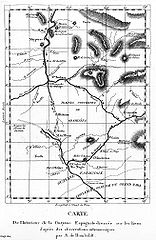Meeting 11 • 12 February 2013 • Tuesday
|
Version: |
|
pictures of the week
|
thought-bite of the week: "Rivers have only a slight, often imperceptible fall.… We stopped by the mouth of the Caño de la Triguera… to measure the speed of the current, which was 2.56 feet an hour."(Humboldt, "Personal Narrative", from Jaguars and Electric Eels, ed. & trans. Wilson, p. 49, 67) |
|
mini-text of the week (start): "In this interior of a new continent you get used to seeing man as not essential to the natural order…"Humboldt, "Personal Narrative", from Jaguars and Electric Eels, ed. & trans. Wilson, pp. 99 (read more) |
|
+ |
(10') This week's thought-bite: the constant measuring and the tiny gradations; Lewis & Clark and the Willamette; science shows that Kansas is as flat as a pancake. Followup about words for "science", "scientist", and the specific sciences: "physico-mathematicall experimentall" (Bryson, book about Royal Society). Sources of information about: the history of words – the Oxford English Dictionary (OED); and the state of knowledge "back then" (=1800) from its own perspective – The Encyclopédie (1751-1772) of Diderot & d'Alembert (Wikipedia; • complete French text in e-facsimile • PSU has it as ink-on-paper facsimile) |
|
√ |
(15') Humboldt's enormous contribution to climate science and the origins of sustainabile environmentalism: the Chimborazo research and the iconic diagram – a brief look, followed by a look at some contemporary discussions. Followup on meeting 10 discussion of "data" and whether X is a "fact": 1) quantity / cost of data in 1800 and now; 2) differences in meaning among "data", "fact", "inference", "conclusion", "opinion", "hypothesis", "theory", "truth". To what extent to we take data, facts, etc. "on faith"? How do we decide what we believe/ accept? Margins for error in Humboldt's time and our own: latitude, longitude, altitude, temperature; news flash: PSU Building World's Biggest Barometer!! |
|
+ |
(20') Hands-on activity: Getting a sense of topographical mapping and organization of other geographical data (temperature, etc.) by plotting our heights (inches beyond base measurement of 5') onto a grid and drawing the lines that connect equal (iso-) heights. This was also the basis for H's path-breaking documentation of climate and life-form zones. More about that ("Chimborazo" - see Helferich, Chapter 9) next meeting. |
| - |
(10') presentation (continuation) about educational standards and their parts in the course, and how that relates to the individual and group projects: helping others to learn - how standards are used to develop curriculum (curricula?) and learning activities – examples: Lyon Arboretum and Hawaii school standards • Hawaii STEM Intercommunity Portal • Enchanted Learning - but one of many sources of learning activities, especially for younger learners. Here's their "Explorers" page about Humboldt. Here's their section about "astronomy:Earth", with activities that could be inspiration for learning activities for Humboldt-named schools. Here is "ThirteenEd Online", about lesson plans (example: math) |
|
- |
(15') Second look at ideas for group projects: which skills do they need / which skills map onto which ideas? Examples of group projects from last year's Humboldt SINQ. Concept of "BIMP" – Big Idea for Major Project, rather than finished, packaged product. Reasons: a) never enough time; b) we're contemplating another SINQ (summer, maybe) and even a Humboldt Capstone. This course's group projects will be handed off (anonymously) to your successors for further development. Into the projects we'll integrate the species descriptions and the foundation for learning materials of use to Humboldt-named schools, or just about any school. You learn best when you have to teach what you've learned. To be an educated, committed citizen is both to learn and to teach. food for thought: How do you know where you learned X? How do you know that what you learned is really true? How/When did you learn how to learn? If you lost your curiosity and interest in learning, how and when did it happen? |
|
(5') Announcements, Checkups & Previews: 1) midterm (outside class) was assigned LAST THURSDAY and is due soon; 1) what it's like to read Darwin; 2) Humboldt-named species; forming teams and scoping out projects; 3) the iconic graphic of Chimborazo; 4) apps Humboldt would have liked; Upcoming: presentation about society back then (and any time before 1800 or so), to help understand how H related to people of other classes / races (teaser: When was it that someone's ears first popped with a change in altitude?) One focus of "interpreting the past" to the present during the rest of the course: land and water allocation and use in the American West |

